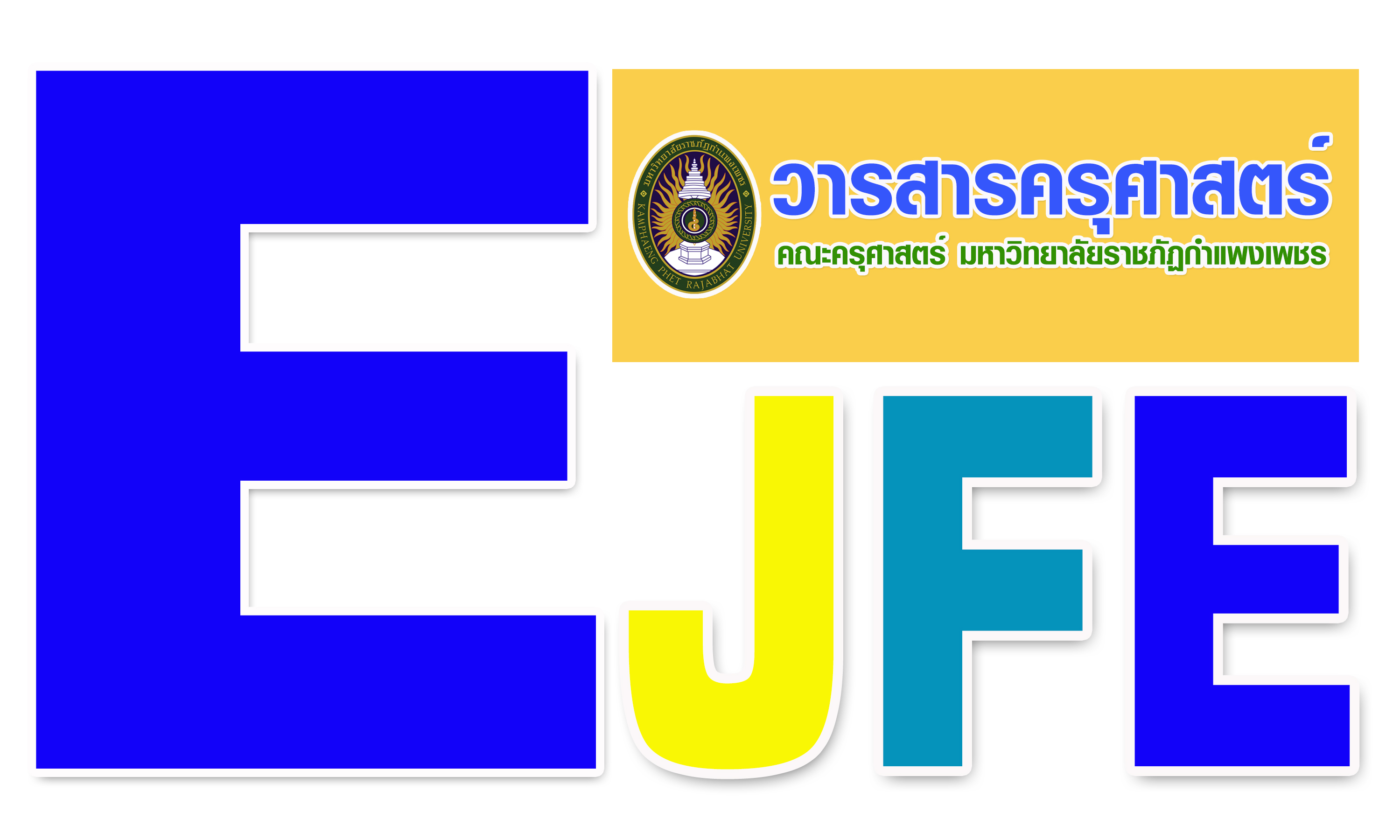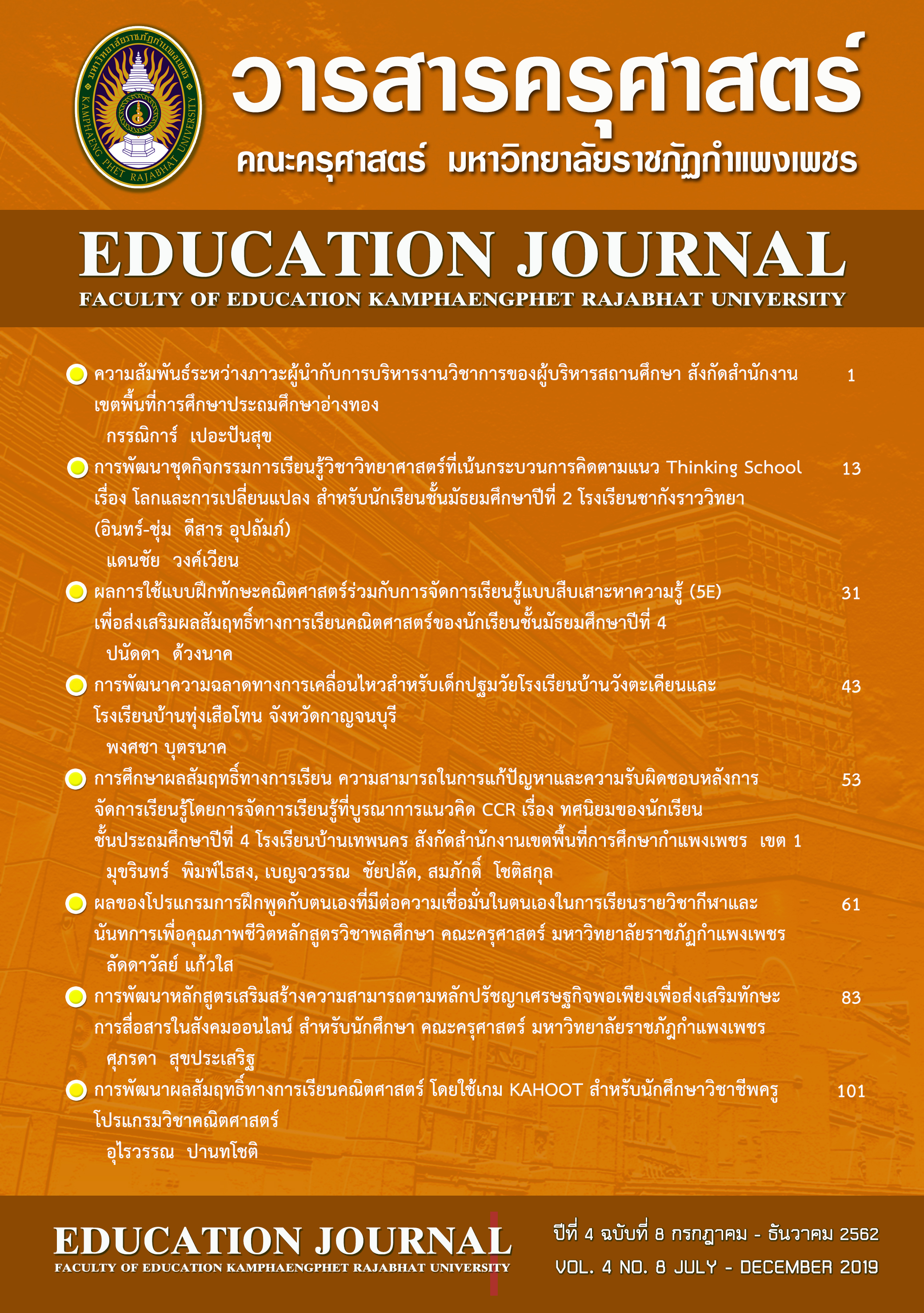DEVELOPMENT OF PRESCHOOL CHILDREN PHYSICAL LITERACY AT BANWANGTAKIAN SCHOOL, MUEANG KANCHANABURI DISTRICT AND BANTHUNGSUEATHON SCHOOL, THONGPHAPHUM DISTRICT
Main Article Content
Abstract
The purpose of this research was to study the needs of the development of physical literacy and to study the efficiency of teachers in using the physical literacy development model. There are 2 steps of operations, which are the survey of the needs for the development of physical literacy. By surveying the sample needs School director and teacher teaching primary level. By interviewing to study the need to develop physical literacy. research result 1. The need to develop physical literacy. Regarding the administration of the Early Childhood Education Curriculum 2017, the school has arranged the teaching and learning according to the Early Childhood Education Curriculum 2017, for the development of early childhood in the physical, emotional, psychological, social, intellectual and content areas. Learning activities for the continuous development of children to develop their children to the fullest Big picture. By focusing on activities that promote observation searching for practice and problem solving throughout the duration of the learning activities, 50-60 minutes each time in organizing movement activities. Teachers should acquire additional knowledge, especially when choosing / organizing activities to improve physical fitness in the body mass index. Agility Body balance. The relationship between nerves and muscles Organizing activities for children to understand critical thinking. Security Care Analysis Able to perform correct movement activities Organizing activities for the development of motorized physical literacy. Teachers need to get a lot of knowledge, especially choosing / setting activities to encourage motivation for children. 2. A study of the efficiency of teachers in using the model to develop physical literacy It was found that the average efficiency of teachers before - after using the model for developing physical literacy Differences were statistically significant at the .05 level.
Article Details

This work is licensed under a Creative Commons Attribution-NonCommercial 4.0 International License.
CC Attribution-NonCommercial-NoDerivatives 4.0
References
กระทรวงศึกษาธิการ. (2560). หลักสูตรการศึกษาปฐมวัย พุทธศักราช 2560. กรุงเทพมหานคร: โรงพิมพ์ชุมชนสหกรณ์การเกษตรแห่งประเทศไทยจำกัด. กฎบัตรโตรอนโตเพื่อกิจกรรมทางกาย: ข้อเสนอระดับโลกเพื่อให้เกิดการปฏิบัติ (The Toronto Charter for Physical Activity: A Global Call for Action) ฉบับปรับปรุงล่าสุดเมื่อ 20 พฤษภาคม 2553. (Online). http://readgur.com/download/2198877, 30 กรกฎาคม 2560.
กรมสุขภาพจิต. (2557). โครงการพัฒนาเด็กปฐมวัยเพื่อรองรับยุทธศาสตร์ชาติ. (Online). http://www.dmh.go.th/downloadportal/Strategy/เด็กปฐมวัย.pdf, 27 กรกฎาคม 2560.
เจริญ กระบวนรัตน์. (2552). ตาราง 9 ช่องกับการพัฒนาสมอง. กรุงเทพมหานคร:โรงพิมพ์บริษัท สินธนาก๊อปปี้เซ็นเตอร์.
นลินี เชื้อวณิชชากร. (2555). 11 ปัญหาสุขภาพลูกน้อยไฮเทคพ่อแม่ต้องตระหนัก.(Online). http://www.amarinbabykidsfair.com/articleview.aspx?AID=20#.VtwDeuaPvVY, 27 กุมภาพันธ์ 2559.
ประเวศ วะสี. (2557). อภิวัฒน์การเรียนรู้...สู่จุดเปลี่ยนประเทศไทย. กรุงเทพมหานคร: สำนักงานส่งเสริมสังคม แห่งการเรียนรู้และคุณภาพเยาวชน (สสค.).
ลดาวัลย์ คำภา. (2559). ยุทธศาสตร์ชาติ 20 ปี Sustainable Development Goals และแผนฯ 12 ของประเทศ. สำนักงานพัฒนาการเศรษฐกิจและสังคมแห่งชาติ.
วาสนา คุณาอภิสิทธิ์. (2559). การพัฒนาหลักสูตรกิจกรรมทางกายสำหรับนักเรียนในประเทศไทย. วารสารสุขศึกษา พลศึกษาและสันทนาการ ปีที่ 42 เล่ม 2 กรกฎาคม-ธันวาคม 2559.
ศูนย์กระตุ้นพัฒนาการเด็ก. (2549). แนวทางการบำบัดปัญหาด้าน Sensory Integration. (Online). http://www.thai-dbp.org/webboard/index.php?pid=journal.,27 กุมภาพันธ์ 2559.
สำนักงานคณะกรรมการการศึกษาแห่งชาติสำนักนายกรัฐมนตรี. 2553. พระราชบัญญัติการศึกษาแห่งชาติ พ.ศ. 2542 แก้ไขเพิ่มเติม (ฉบับที่ 2) พ.ศ. 2545 และ (ฉบับที่ 3) พ.ศ. 2553. ม.ป.ท.
สำนักงานคณะกรรมการพัฒนาการเศรษฐกิจและสังคมแห่งชาติ. (2559). ทิศทางของแผนพัฒนาเศรษฐกิจและสังคมแห่งชาติ ฉบับที่ 12. เอกสารประกอบการระดมความคิดเห็นทิศทางแผนพัฒนาฯ ฉบับที่ 12.
สำนักงานคณะกรรมการการศึกษาแห่งชาติ สำนักนายกรัฐมนตรี. (2553). พระราชบัญญัติการศึกษาแห่งชาติ พ.ศ. 2542 แก้ไขเพิ่มเติม (ฉบับที่ 2) พ.ศ. 2545 และ (ฉบับที่ 3) พ.ศ. 2553. ม.ป.ท.
สำนักงานเลขาธิการสภาการศึกษา กระทรวงศึกษาธิการ. (2550). การเรียนรู้ของเด็กปฐมวัยไทย: ตามแนวคิดไฮสโคป. พิมพ์ครั้งที่ 2. ห้างหุ่นส่วนจำกัด วี.ที.ซี. คอมมิวนิเคชั่น.
สำนักงานเลขาธิการสภาการศึกษา กระทรวงศึกษาธิการ. 2552. สมรรถนะของเด็กปฐมวัยในการพัฒนาตามวัย 3-5 ปี. พิมพ์ครั้งที่ 1.บริษัท แปลน ฟอร์ คิดส์ จำกัด.
สำนักมาตรฐานการศึกษาและพัฒนาการเรียนรู้ สำนักงานเลขาธิการสภาการศึกษา. (2550).นโยบายและยุทธศาสตร์การพัฒนาเด็กปฐมวัย (0-5 ปี) ระยะยาว พ.ศ. 2550-2559. พิมพ์ครั้งที่ 1. กรุงเทพมหานคร: ห้างหุ้นส่วนจำกัด วี.ที.ซี. คอมมิวนิเคชั่น.
สุริยา ฆ้องเสนาะ. (2558). การศึกษาของเด็กปฐมวัยหัวใจสำคัญของการศึกษา. สำนักวิชาการสำนักงานเลขาธิการสภาผู้แทนราษฎร.สำนักงานส่งเสริมสังคมแห่งการเรียนรู้และคุณภาพเยาวชน (สสค.). (2557). พัฒนาการเด็กปฐมวัยรากแก้วแห่งชีวิต. พิมพ์ครั้งที่ 1. บริษัท สหมิตรพริ้นติ้งแอนด์พับลิสซิ่ง จำกัด.
รถจนา เถาพันธ์. (2549). พระราชดำรัสสมเด็จพระเทพรัตนราชสุดาเนื่องในวันครูโลก. วารสารวงการครู.
Margaret Whitehead. (2011). Physical Literacy: Throughout the Life course. International Studies in Physical Education and Young Sport.Singer, D. (2006). Play=Learning. London: Oxford University Press.


